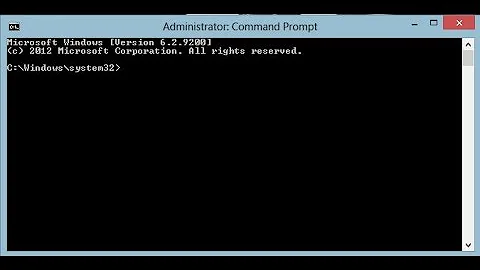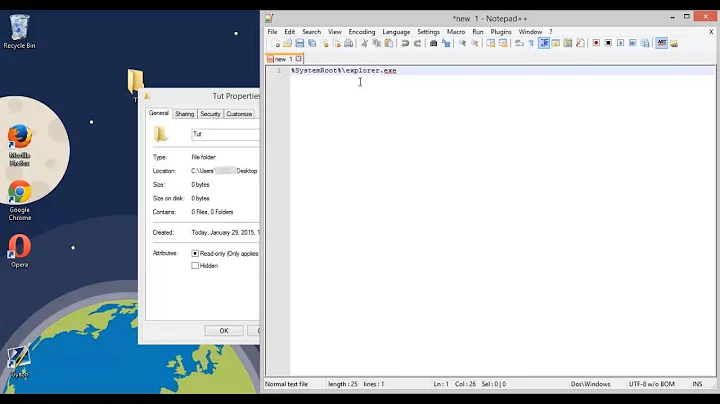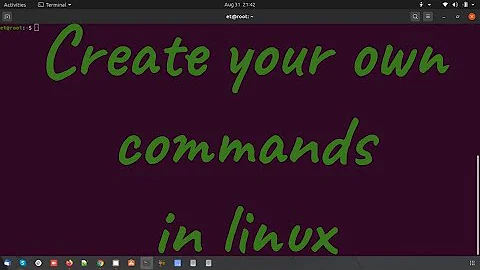How to make a shortcut from CMD?
Solution 1
There is some very useful information on this site: http://ss64.com/nt/shortcut.html
Seems like there is some shortcut.exe in some resource kit which I don't have.
As many other sites mention, there is no built-in way to do it from a batch file.
But you can do it from a VB script:
Optional sections in the VBscript below are commented out:
Set oWS = WScript.CreateObject("WScript.Shell")
sLinkFile = "C:\MyShortcut.LNK"
Set oLink = oWS.CreateShortcut(sLinkFile)
oLink.TargetPath = "C:\Program Files\MyApp\MyProgram.EXE"
' oLink.Arguments = ""
' oLink.Description = "MyProgram"
' oLink.HotKey = "ALT+CTRL+F"
' oLink.IconLocation = "C:\Program Files\MyApp\MyProgram.EXE, 2"
' oLink.WindowStyle = "1"
' oLink.WorkingDirectory = "C:\Program Files\MyApp"
oLink.Save
So, if you really must do it, then you could make your batch file write the VB script to disk, invoke it and then remove it again. For example, like so:
@echo off
echo Set oWS = WScript.CreateObject("WScript.Shell") > CreateShortcut.vbs
echo sLinkFile = "%HOMEDRIVE%%HOMEPATH%\Desktop\Hello.lnk" >> CreateShortcut.vbs
echo Set oLink = oWS.CreateShortcut(sLinkFile) >> CreateShortcut.vbs
echo oLink.TargetPath = "C:\Windows\notepad.exe" >> CreateShortcut.vbs
echo oLink.Save >> CreateShortcut.vbs
cscript CreateShortcut.vbs
del CreateShortcut.vbs
Running the above script results in a new shortcut on my desktop:

Here's a more complete snippet from an anonymous contributor (updated with a minor fix):
@echo off
SETLOCAL ENABLEDELAYEDEXPANSION
SET LinkName=Hello
SET Esc_LinkDest=%%HOMEDRIVE%%%%HOMEPATH%%\Desktop\!LinkName!.lnk
SET Esc_LinkTarget=%%SYSTEMROOT%%\notepad.exe
SET cSctVBS=CreateShortcut.vbs
SET LOG=".\%~N0_runtime.log"
((
echo Set oWS = WScript.CreateObject^("WScript.Shell"^)
echo sLinkFile = oWS.ExpandEnvironmentStrings^("!Esc_LinkDest!"^)
echo Set oLink = oWS.CreateShortcut^(sLinkFile^)
echo oLink.TargetPath = oWS.ExpandEnvironmentStrings^("!Esc_LinkTarget!"^)
echo oLink.Save
)1>!cSctVBS!
cscript //nologo .\!cSctVBS!
DEL !cSctVBS! /f /q
)1>>!LOG! 2>>&1
Solution 2
Here's a similar solution using powershell (I know, you can probably re-write your whole batch file in PS, but if you just want to Get It Done™...)
set TARGET='D:\Temp'
set SHORTCUT='C:\Temp\test.lnk'
set PWS=powershell.exe -ExecutionPolicy Bypass -NoLogo -NonInteractive -NoProfile
%PWS% -Command "$ws = New-Object -ComObject WScript.Shell; $s = $ws.CreateShortcut(%SHORTCUT%); $S.TargetPath = %TARGET%; $S.Save()"
You may have to explicity specify the path to PS in your file, but it should work. There are some additional attributes you can mangle through this object, too:
Name MemberType Definition
---- ---------- ----------
Load Method void Load (string)
Save Method void Save ()
Arguments Property string Arguments () {get} {set}
Description Property string Description () {get} {set}
FullName Property string FullName () {get}
Hotkey Property string Hotkey () {get} {set}
IconLocation Property string IconLocation () {get} {set}
RelativePath Property string RelativePath () {set}
TargetPath Property string TargetPath () {get} {set}
WindowStyle Property int WindowStyle () {get} {set}
WorkingDirectory Property string WorkingDirectory () {get} {set}
Solution 3
Besides shortcut.exe, you can also use the command line version of NirCmd to create shortcut. http://nircmd.nirsoft.net/shortcut.html
Solution 4
How about using mklink command ? C:\Windows\System32>mklink Creates a symbolic link.
MKLINK [[/D] | [/H] | [/J]] Link Target
/D Creates a directory symbolic link. Default is a file
symbolic link.
/H Creates a hard link instead of a symbolic link.
/J Creates a Directory Junction.
Link specifies the new symbolic link name.
Target specifies the path (relative or absolute) that the new link
refers to.
Solution 5
After all the discussions we had here, this is my suggested solution:
download: http://optimumx.com/download/Shortcut.zip
extract it on your desktop (for example).
Now, suppose you want to create a shortcut for a file called scrum.pdf (also on desktop):
1. open CMD and go to desktop folder
2. run: Shortcut.exe /f:"%USERPROFILE%\Desktop\sc.lnk" /a:c /t:%USERPROFILE%\Desktop\scrum.pdf
it will create a shortcut called sc.lnk on your desktop that will point to the original file (scrum.pdf)
Related videos on Youtube
Mahmoud Moustafa
Updated on September 18, 2022Comments
-
 Mahmoud Moustafa about 1 year
Mahmoud Moustafa about 1 yearThis is another I'm-totally-new-to-Ruby-please-have-mercy situation.
So i'm trying to figure out how to make a database of all my buttons to save the click count each time they're clicked. I started a
new railsto try it out and generated amodel Buttonand acontroller buttons indexroute.rbs
Rails.application.routes.draw do resources :buttons root 'buttons#index' endmigration
class CreateButtons < ActiveRecord::Migration[5.0] def change create_table :buttons do |t| t.integer :clicks t.timestamps end end endbuttons_controller
class ButtonsController < ApplicationController def index @button = Button.find(1) end def doit @button = Button.find(1) @newcount = @button.clicks + 1 Button.find(1).update_attributes(:clicks => @newcount) end endNow.. i need to trigger the doit method.. is it possible to trigger a non CRUD operation ? i tried this but it doesn't seem to work index.html.erb
<h1>Hello, This is button and my click are :</h1> <h1><%= @button.clicks %></h1> <%= link_to 'click me', method: :doit %>I know there's something I'm not getting here... Ruby have been doing so much magic that I can't do a simple ruby method.. it have been really hard for me getting the part were methods are taking place without calling them by name.. Specially when I trigger a delete method and the destroy method is triggered by that.. I really need to get used to this too-much-magic coding
-
 Admin over 11 yearsThere doesn't appear to be any straightforward way to do that. Some people have written tools that let you do it; here's one of them. A Google search for "windows create shortcut command line" turns up some others. (I haven't tried any of them.)
Admin over 11 yearsThere doesn't appear to be any straightforward way to do that. Some people have written tools that let you do it; here's one of them. A Google search for "windows create shortcut command line" turns up some others. (I haven't tried any of them.) -
 Admin over 11 years@iglvzx - I'm not sure that the editing you did is correct. I don't think that Shantanu needs a batch script - it could be any way of creating a *.lnk to another *.exe file.
Admin over 11 years@iglvzx - I'm not sure that the editing you did is correct. I don't think that Shantanu needs a batch script - it could be any way of creating a *.lnk to another *.exe file. -
 Admin about 6 yearsUse the following: powershell "$s=(New-Object -COM WScript.Shell).CreateShortcut('%userprofile%\Desktop\shortcut.lnk');$s.TargetPath='C:\Windows\';$s.Save()" Obviously, replace "'%userprofile%\Desktop\shortcut.lnk" and "C:\Windows\" with your shortcut path and target path, respectively.
Admin about 6 yearsUse the following: powershell "$s=(New-Object -COM WScript.Shell).CreateShortcut('%userprofile%\Desktop\shortcut.lnk');$s.TargetPath='C:\Windows\';$s.Save()" Obviously, replace "'%userprofile%\Desktop\shortcut.lnk" and "C:\Windows\" with your shortcut path and target path, respectively. -
 Admin about 6 years@cowlinator As typed, your suggestion does not work.
Admin about 6 years@cowlinator As typed, your suggestion does not work. -
 Admin almost 6 years@Ploni, it does work for me on my computer. What error message are you seeing? What is your powershell execution policy?
Admin almost 6 years@Ploni, it does work for me on my computer. What error message are you seeing? What is your powershell execution policy? -
 Admin almost 6 years@cowlinator Strange. Now it works for me too.
Admin almost 6 years@cowlinator Strange. Now it works for me too. -
 Admin almost 6 yearsThat's good to hear, if a bit mystifying. If anybody else is having issues, you can try typing the following directly into powershell: $s=(New-Object -COM WScript.Shell).CreateShortcut($Env:userprofile + '\Desktop\shortcut.lnk');$s.TargetPath='C:\Windows\';$s.Save()
Admin almost 6 yearsThat's good to hear, if a bit mystifying. If anybody else is having issues, you can try typing the following directly into powershell: $s=(New-Object -COM WScript.Shell).CreateShortcut($Env:userprofile + '\Desktop\shortcut.lnk');$s.TargetPath='C:\Windows\';$s.Save() -
 Admin over 5 years@cowlinator your comment contains multiple zero-width / non-printable characters. As you are asking users to copy and paste this into their command line, this can look quite bad from a security perspective. Please remove them and format your comment as raw string.
Admin over 5 years@cowlinator your comment contains multiple zero-width / non-printable characters. As you are asking users to copy and paste this into their command line, this can look quite bad from a security perspective. Please remove them and format your comment as raw string. -
 Admin over 5 yearsFor anyone interested, here is a cleaned version of @cowlinator's comment:
Admin over 5 yearsFor anyone interested, here is a cleaned version of @cowlinator's comment:powershell "$s=(New-Object -COM WScript.Shell).CreateShortcut('%userprofile%\Desktop\shortcut.lnk');$s.TargetPath='C:\Windows\';$s.Save()" -
 Admin over 5 years@zsero, I was concerned about your comment, so I copy/pasted both of my above comments into notepad++ and selected "show all characters", but I found no non-printable characters. Also, I'd be pretty pretty surprised if stack-exchange sites didn't sanitize their inputs. What makes you believe there are non-printable characters there?
Admin over 5 years@zsero, I was concerned about your comment, so I copy/pasted both of my above comments into notepad++ and selected "show all characters", but I found no non-printable characters. Also, I'd be pretty pretty surprised if stack-exchange sites didn't sanitize their inputs. What makes you believe there are non-printable characters there? -
 Admin over 5 years@cowlinator in Chrome, right click: Inspect on your text to see it has 3 occurances of
Admin over 5 years@cowlinator in Chrome, right click: Inspect on your text to see it has 3 occurances ofin it.
-
-
 Nir Alfasi over 11 yearsa shortcut is something you run from windows, since he used CMD in the title and put the tag "command-line" I assumed he wants to run it from CMD. A batch file is the equivalent of a windows "shortcut" when you run in CMD (dos like) env.
Nir Alfasi over 11 yearsa shortcut is something you run from windows, since he used CMD in the title and put the tag "command-line" I assumed he wants to run it from CMD. A batch file is the equivalent of a windows "shortcut" when you run in CMD (dos like) env. -
 Keith Thompson over 11 yearsSince he put "shortcut (.lnk file)" in the body of the question, I assumed he wants to create an actual shortcut.
Keith Thompson over 11 yearsSince he put "shortcut (.lnk file)" in the body of the question, I assumed he wants to create an actual shortcut. -
 Shantanu over 11 yearssorry for clarity i wanted to have a icon on my desktop that i made in cmd that would be a shortcut to a exe file
Shantanu over 11 yearssorry for clarity i wanted to have a icon on my desktop that i made in cmd that would be a shortcut to a exe file -
 iglvzx over 11 yearsRelated: MSDN, Shell Links
iglvzx over 11 yearsRelated: MSDN, Shell Links -
 Nir Alfasi over 11 yearsnow that I finally understood (slow thinker - what can you do...) I changed my answer. hope it helps!
Nir Alfasi over 11 yearsnow that I finally understood (slow thinker - what can you do...) I changed my answer. hope it helps! -
 Walter Stabosz over 9 yearsGood idea, but symlinks appear to behave a bit differently than shortcuts. If I create a shortcut to a Visual Studio solution, it opens all the relatively-pathed-projects correctly. However, if I open the same solution via a symlink, the working directory is that of the path in which the symlink resides, not the path to which it refers.
Walter Stabosz over 9 yearsGood idea, but symlinks appear to behave a bit differently than shortcuts. If I create a shortcut to a Visual Studio solution, it opens all the relatively-pathed-projects correctly. However, if I open the same solution via a symlink, the working directory is that of the path in which the symlink resides, not the path to which it refers. -
 Nir Alfasi about 9 years@twasbrillig works for me...
Nir Alfasi about 9 years@twasbrillig works for me... -
 EDM over 7 yearsThis works great for shortcut to a file. However, i'm having a weird problem using it for shortcut to a folder, when my variable Esc_LinkTarget contains an environment variable trying to get its parent folder. (Something like %CD%\.. does not work, but %CD% works). The shortcut target type becomes a 'File' instead of 'Folder'
EDM over 7 yearsThis works great for shortcut to a file. However, i'm having a weird problem using it for shortcut to a folder, when my variable Esc_LinkTarget contains an environment variable trying to get its parent folder. (Something like %CD%\.. does not work, but %CD% works). The shortcut target type becomes a 'File' instead of 'Folder' -
 Oliver Salzburg over 7 years@Edmund Interesting problem. I don't have time to look into it, but I would assume a trailing slash could make a difference.
Oliver Salzburg over 7 years@Edmund Interesting problem. I don't have time to look into it, but I would assume a trailing slash could make a difference. -
 LPChip over 7 yearsIf this is the approach to take, it is better to create the actual shortcut (.lnk) which embeds the icon in it. That shortcut can then be copied everywhere.
LPChip over 7 yearsIf this is the approach to take, it is better to create the actual shortcut (.lnk) which embeds the icon in it. That shortcut can then be copied everywhere. -
 Mahmoud Moustafa about 7 yearsI had a problem with the
Mahmoud Moustafa about 7 yearsI had a problem with theonly: [:index]syntax but once i switched it withonly: :indexthe code worked. Now i know that i have to stick with the CRUD operations.. i can't just run a method randomly -
 Black about 6 yearsNote: if you use
Black about 6 yearsNote: if you useSET Esc_LinkTarget=%0then you have to remove the"fromecho oLink.TargetPath = oWS.ExpandEnvironmentStrings^(!Esc_LinkTarget!^) -
 Scott - Слава Україні almost 6 yearsTrix: If you believe that you have a better way of doing this, just post it as a new answer (linking to this one, if appropriate).
Scott - Слава Україні almost 6 yearsTrix: If you believe that you have a better way of doing this, just post it as a new answer (linking to this one, if appropriate). -
 Sancarn over 4 yearsInstead of creating a vbscript for each execution it would have been far better to use
Sancarn over 4 yearsInstead of creating a vbscript for each execution it would have been far better to useWscript.Argumentsto get the command line arguments... lol -
 GabrielBB over 4 yearsWorks like a charm. I liked the "Not complete snippet" more lol
GabrielBB over 4 yearsWorks like a charm. I liked the "Not complete snippet" more lol -
 Egon Stetmann. over 4 yearsthank you so much!!
Egon Stetmann. over 4 yearsthank you so much!! -
 Antares over 3 yearsWhile I can understand the confusion, the question is about creating the "shortcut file" or "link file" (extension .lnk) of a shortcut itself. Your answer explains how to give an existing shortcut file a keyboard "shortcut". Your answer does not fit the question. But I will not downvote. It is well written and pictured and was given in good faith. I'd say it deserves an upvote just for the effort taken to compose it.
Antares over 3 yearsWhile I can understand the confusion, the question is about creating the "shortcut file" or "link file" (extension .lnk) of a shortcut itself. Your answer explains how to give an existing shortcut file a keyboard "shortcut". Your answer does not fit the question. But I will not downvote. It is well written and pictured and was given in good faith. I'd say it deserves an upvote just for the effort taken to compose it. -
 Antares over 3 yearsUpvote given. At least, it does not deserve a negative score.
Antares over 3 yearsUpvote given. At least, it does not deserve a negative score. -
 TamaMcGlinn about 3 years@Sancarn I have implemented that; also I didn't need to generate and then delete at all, in my case I can just leave the vbscript where it is. however, I am unfortunately unable to post my answer because someone marked this question as protected, and stackoverflow is for some arbitrary reason a separate site from superuser. :( unfortunate because the resulting solution is much simpler than all the others posted here.
TamaMcGlinn about 3 years@Sancarn I have implemented that; also I didn't need to generate and then delete at all, in my case I can just leave the vbscript where it is. however, I am unfortunately unable to post my answer because someone marked this question as protected, and stackoverflow is for some arbitrary reason a separate site from superuser. :( unfortunate because the resulting solution is much simpler than all the others posted here. -
 Sancarn about 3 years@TamaMcGlinn Indeed, you can suggest edits to other people's answers, but protected threads are always a bit sad. I message to the mods might help getting it unlocked to post your answer :).
Sancarn about 3 years@TamaMcGlinn Indeed, you can suggest edits to other people's answers, but protected threads are always a bit sad. I message to the mods might help getting it unlocked to post your answer :). -
 Hannes Schneidermayer about 3 yearsVery good nswer
Hannes Schneidermayer about 3 yearsVery good nswer -
 user1696603 about 3 yearsWith the Git I have (verison 2.27.0.windows.1) I had to dig to find this file as it wasn't referenced in PATH. Found in
user1696603 about 3 yearsWith the Git I have (verison 2.27.0.windows.1) I had to dig to find this file as it wasn't referenced in PATH. Found inC:\Program Files\Git\mingw64\bin -
 Jimadine about 3 years@mattwilkie The path to the exe is indicated in 'Example usage' above, with a note about PATH
Jimadine about 3 years@mattwilkie The path to the exe is indicated in 'Example usage' above, with a note about PATH -
 user1696603 about 3 yearsAhh, I see that now. I missed on first read because text field scrolled off right of screen (and my hasty reading).
user1696603 about 3 yearsAhh, I see that now. I missed on first read because text field scrolled off right of screen (and my hasty reading). -
 loved.by.Jesus almost 3 yearsI am almost in tears: what a powerful piece of code!!! I have been trying to create a .lnk in WINE (Linux) to no avail. Your code did the job. I really appreciate that it uses the most basic tools .bat script and visual basic—no need of "power"shell. Thanks!
loved.by.Jesus almost 3 yearsI am almost in tears: what a powerful piece of code!!! I have been trying to create a .lnk in WINE (Linux) to no avail. Your code did the job. I really appreciate that it uses the most basic tools .bat script and visual basic—no need of "power"shell. Thanks! -
 Tomas Tintera over 2 yearsAlso creating simlink requires admin privilege.
Tomas Tintera over 2 yearsAlso creating simlink requires admin privilege. -
 Admin over 1 yearWouldn't it be more robust to check for
Admin over 1 yearWouldn't it be more robust to check forwhere git.exe, then use that to determine the correct path of thecreate-shortcut.exebased on that? After all hardcoding paths isn't exactly the smartest idea. Even just using%ProgramFiles%\Gitin place ofC:\Program Files\Gitwould improve this quite a bit. -
 Admin over 1 yearIf you are scripting it, and are unsure of the environment i.e. where git might be installed to, yes, that would certainly be worthwhile. But the OP's question isn't about scripting the creation of shortcuts, nor is my answer.
Admin over 1 yearIf you are scripting it, and are unsure of the environment i.e. where git might be installed to, yes, that would certainly be worthwhile. But the OP's question isn't about scripting the creation of shortcuts, nor is my answer.




